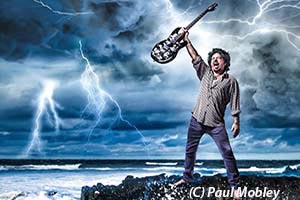Part 1
The cd offers the first in a three-part series of video lessons, including warm-up exercises (that helped Luke develop that devasting speed), playing with Larry Carlton (a demo of playing an A major scale over the E) and a demo which shows Luke soloing on a pumping rock groove, based on chords from E Mixolydian. In the magazine Pete Whittard provides us with 4 pages of background information and guitar tabs related to the demos on the cd.
Pete Whittard: "The picking exercise is deceptively simple to play, but very hard to play accurately fast. It simply moves up and down through the Em Pentatonic. It's so demanding because he double-picks every note, menaing that each pair starts with a downstroke. This is very hard to play cleanly as you move from a higher to a lower string. For his fretting hand, Luke deadens off the strings and moves a three-note legato pattern around the guitar. He comments that Satriani also does a similar thing. Obviously you could run any of your scale shapes in this way."
Lukather about Larry Carlton: "He's a genius. He thinks harmony all the time, where most guitar players think linearly." Pete Whittard: "What he (Luke) demonstrates here is how to think of different tonal areas over a static E blues sound, to add to the common or garden E Major and minor Pentatonic sounds."
Pete Whittard about the solo on the pumping rock groove (demo 3): "This was Luke's second take of the solo. He produced an equally brillant solo first time, but we didn't have our machine in record, as we thought he would like to hear what he was going to play over first. But he just went straight at it! 'Always keep it in record, man,' he said. 'Rule number one! So many great takes were lost because the producer sat there staring at us!' Needless to say we stuck it in record from the off, for the rest of the session!"
Part 2
Part 2 of Luke's video lessons for Guitar Techniques is a lesson in emotive soloing. Steve Lukather was described as a soloing machine by the great Jennifer Batten (Michael Jackson, Jeff Beck). On the three videoclips on the cd Luke talks about his songwriting and personal direction and he plays a solo variation on Hendrix's Little wing.
Pete Whittard: "Luke is renowned for being a first-take guitarist; in fact he really wanted to know during the interview how long the solo should be and what key it was in! One great thing to appreciate from seeing him rip out solos like this is the fact that he has a great store of useable vocabulary on the guitar. He doesn't have to think about working a lick into a solo, it's there ready to be shown on. The backing of this particular solo consists of chords drawn mostly from the E natural minor, or Aeolian mode. However, just to spice up the ending we stuck in a B7 chord, which is drawn from the E Harmonic minor scale and is often used at the end of this type of sequence. Gary Moore's Parisienne walkways and Still got the blues being two good examples that spring to mind."
Part 3
In part 3 of his lessons for GT Steve Lukather discusses with Pete Whittard the studio tricks that players like Ray Parker Jr use to create fancy guitar parts. On the three video clips on the cd Luke explains the main lessons he learned from Ray Parker (Ray Parker for funk), how to arrange rhythm parts (Effective rhythm parts) and shows how to build a funky groove.
Firstly, Luke let us in on a tip that 70's funk guitar legend Ray Parker Jr passed onto him during a session. It involves using dead strings to add a scratch or, as Luke calls it, a skank, to an E-based riff. This technique enables Luke to keep the feel of the rhythm guitar moving along, by putting dead notes in between the legitimate notes of the riff. This creates a full sound, and by keeping the hand moving sustains a consistant groove.
The next set of examples is all about buidling up a groove with lots of smaller overdubs. Luke did this all off-the-cuff, and what he's attempting to do is place each part in a space left by the other parts.
Luke also explained a studio tip when mixing these types of guitar parts. If all of the guitars are the same volume, tone and position in the stereo image, they will fight for your attention. The result then sounds muddy and confused.
Pete Whittard, One-to-one with Steve Lukather, Guitar Techniques, January, February & March 2005




